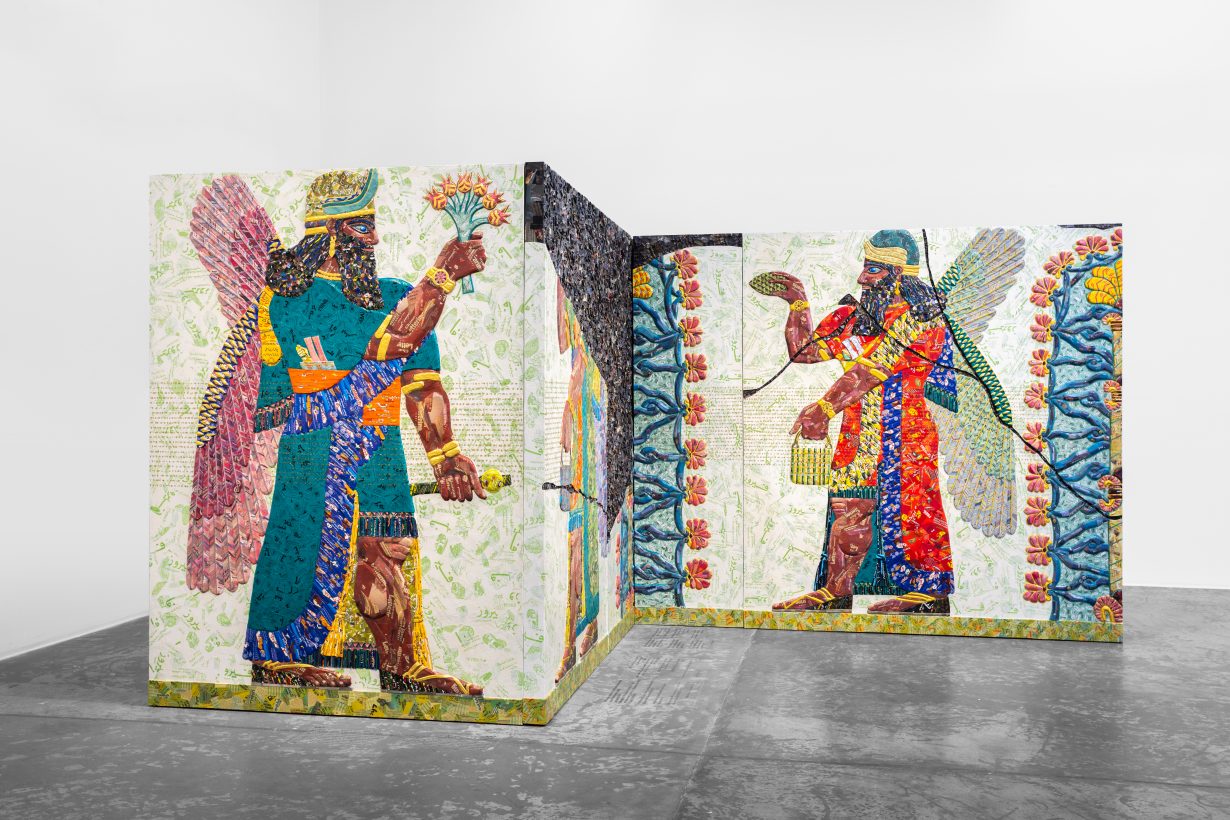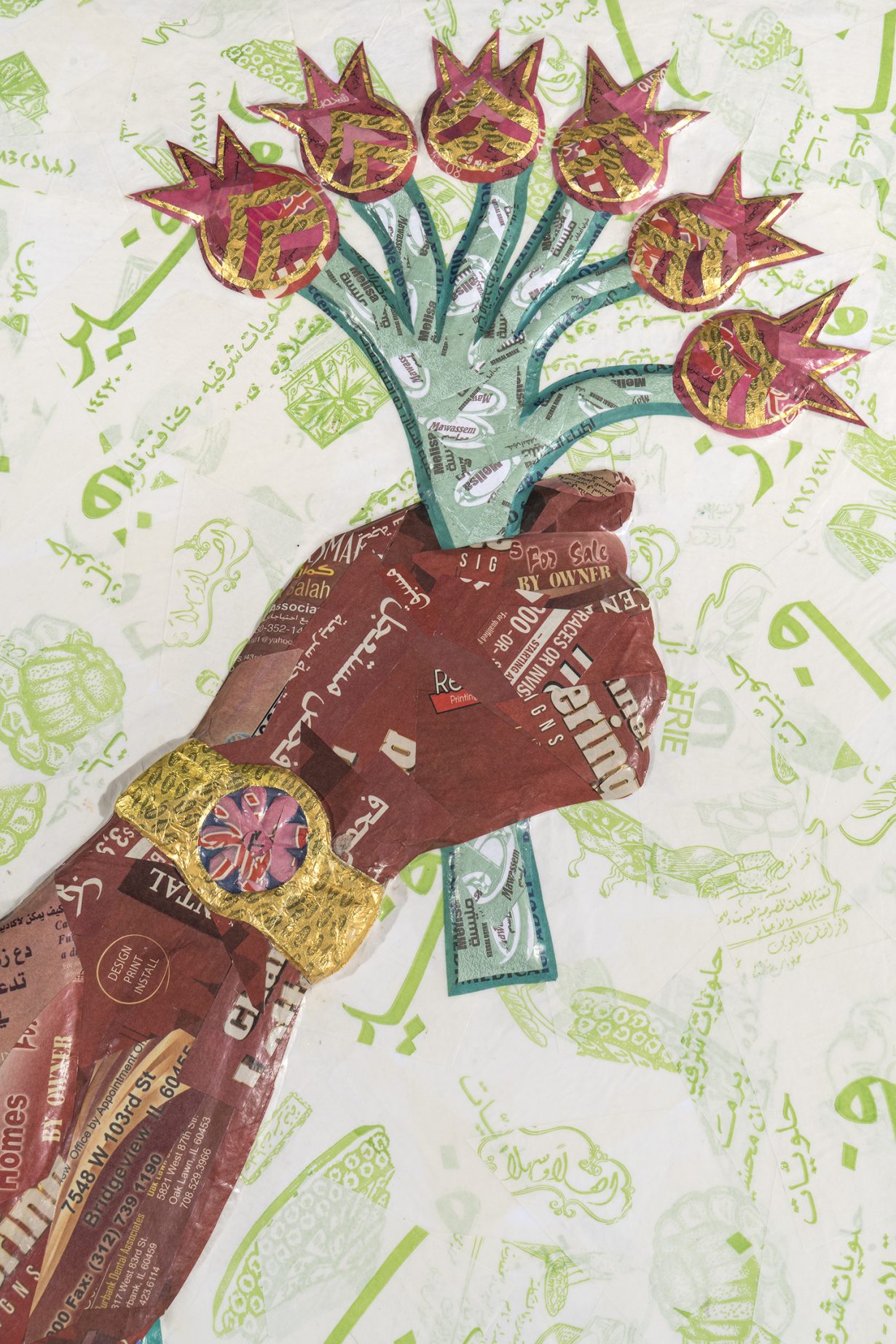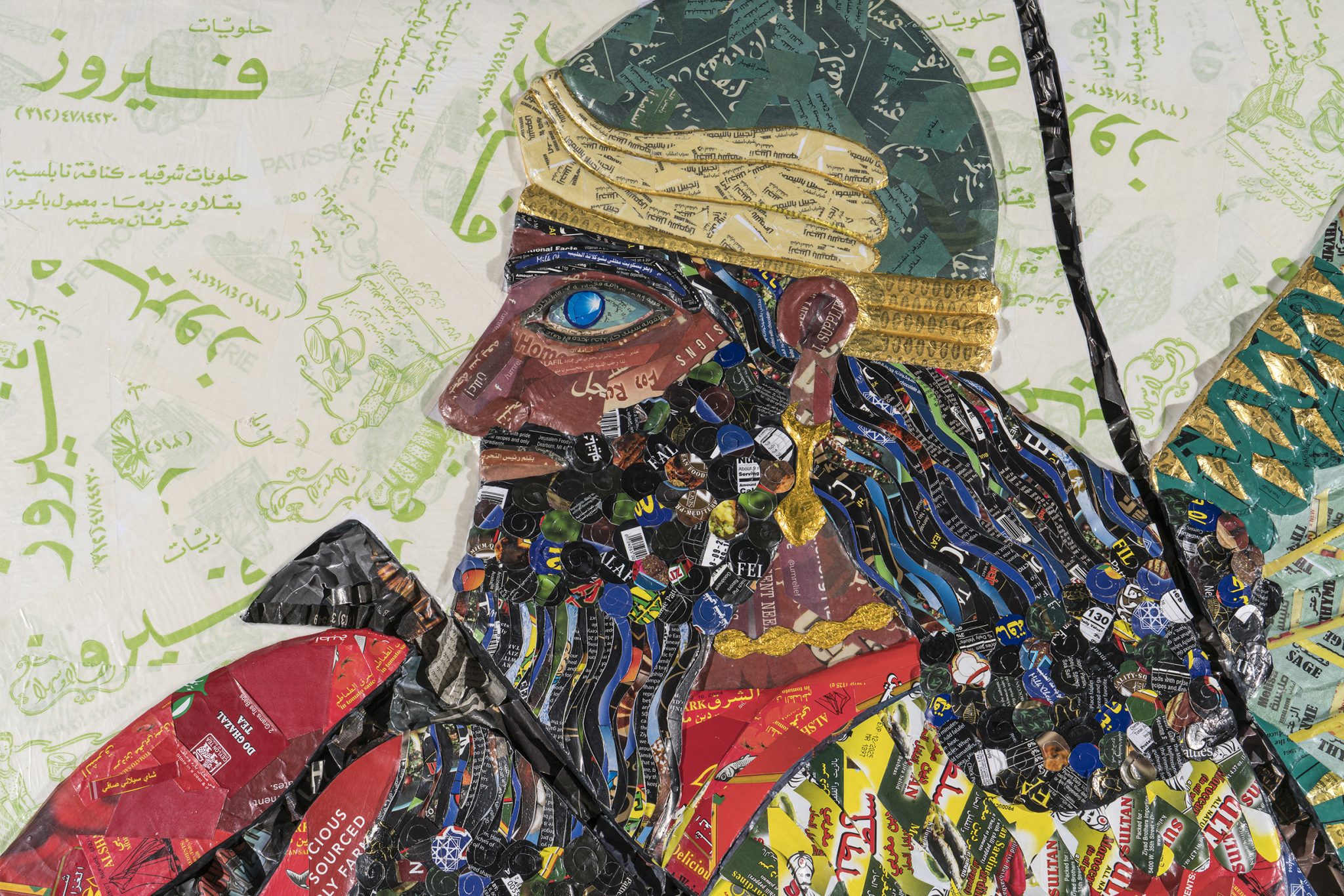The artist’s The invisible enemy should not exist… at Green Art Gallery, Dubai is a sensitive reconstruction of ancient Iraqi history that offers something beyond nostalgia
On entering this exhibition, I’m immediately drawn to a series of colourful panels depicting familiar winged figures: logos and words in English and Arabic are revealed in the layered spirals of their beards, the feathers of their wings, their horned helmets and decorated wrists, the tasselled garments that wrap and drape around their bodies, and their skin. They say things like ‘halal chicken flavored bouillon’, ‘Medjool dates’ and ‘eastern sweets’. These paper-collage reliefs are Rakowitz’s latest reconstructions of the sculptural originals that adorned the walls of the ancient Assyrian Northwest Palace of Kalhu (Nimrud) near present-day Mosul, Iraq. Institutions in Europe and the US have excavated such creations at the palace since the mid-1800s (with artefacts kept at institutions including the British Museum, London, and the Metropolitan Museum of Art, New York). Any panels that remained after this looting were destroyed by ISIS in 2015. Drawing from databases of reference images, Rakowitz rebuilds the reliefs using polychromatic papier-mâché made of West Asian food- packaging and Arabic-English newspapers (including for the first time fragments from old issues of Nineveh, 1977–, a quarterly publication in Modern Assyrian and English donated to Rakowitz’s studio by the Assyrian Foundation of America). Having been exhibited in cities across the United States (the Iraqi-American artist lives in Chicago), such materials provide moments of Arab cultural visibility beyond oil and war.

Rakowitz began the ongoing project The invisible enemy should not exist in 2007, in an effort to ‘reappear’ threatened, destroyed and missing artefacts and architecture of Assyrian cultural heritage. The title is a translation of ‘Aj ibur shapu’, the name of the processional way that ran through Nebuchadnezzar’s Ishtar Gate in Babylon, and invites us to consider who the invisible enemy really is; in the context of Rakowitz’s work, one can infer that this points to those who perpetrated the looting and erasure of Assyrian cultural artefacts. In 2018 Rakowitz embarked on recreating each room of the Northwest Palace of Kalhu, which, for one-and-a-half centuries of the Assyrian empire’s 300-year-history served as its administrative centre and King Ashurnasirpal II’s principal residence. On show here is a section of ‘Room S’, and what would have been a reception hall. Glancing down, my eyes are caught by museum labels accompanied by quotes, both in English and Arabic, stuck to the floor. For example, the label for a section of wall, ‘S-13’, provides a description (‘panel with right half of tree’), a location, the years it was excavated and acquired, and a quote by someone only identified as ‘Amar’ that reads, ‘We feel sad as a lot of people in the villages worked at Nimrud. People would come from all over Iraq to visit this palace and now it’s gone.’ There are more labels spread out across the gallery floor. They require you to reorient mentally inside the gallery’s space, imagining walls and the spaces between them as you follow the labels in sequence. An integral part of the installation, the labels indicate the empty spaces left by extant panels held in private collections or Western institutions. Combined with Rakowitz’s own remodelling of panels that remained in the palace until their destruction in 2015, the installation transports visitors to the site just before it was destroyed by ISIS.


Much of Rakowitz’s practice is concerned with themes of knowledge, belonging, removal and loss in relation to Iraq. Hanging across one of the walls of the exhibition is Charita Baghdad (2020). The largescale sheet of archival paper features a series of digital prints of the pages of a 1936 Passover Haggadah belonging to the Baghdadi Jewish community. Stains on the browned pages of the book become parts of sketches that flow over the pages’ borders, depicting maps of Palestine and Iraq, and alongside them graphite illustrations of votive sculptures from Tell Asmar (a collection of c. 2900–2550 BCE figures uncovered in 1933) and of the artist’s grandfather, as well as arrows that point to pencilled notations: ‘The word “Allah” in Arabic-in-Hebrew letters’ and ‘So, why is Arabic written in Hebrew letters for the Iraqi Jewish community?’. Such close page-by-page analysis of this Hebrew prayer- book brings into question the contested identity of the Arab Jew. Rakowitz provides significant and critical examinations of pressing issues of erasure, identity and restitution that are tied regionally and internationally. Here, in a gallery in the Middle East, about 1,400km from Baghdad, these works are weighted by a sense of loss. But they also offer a valuable opportunity for people who have stakes in these materials and histories to connect more closely with what they were stripped of, and offer a more tender encounter with stolen and displaced artefacts than one might experience within the context of the Western museums in which much of Assyrian culture is held. The invisible enemy… isn’t about a full return of those lost objects, but about the metaphors and materials that constitute the work. They offer something beyond nostalgia, as close and sensitive a revival of ancient Iraqi history and culture as we might have left.
The invisible enemy should not exist (Northwest Palace of Kalhu, Room S, Western Entrance) at Green Art Gallery, Dubai, through 23 November
